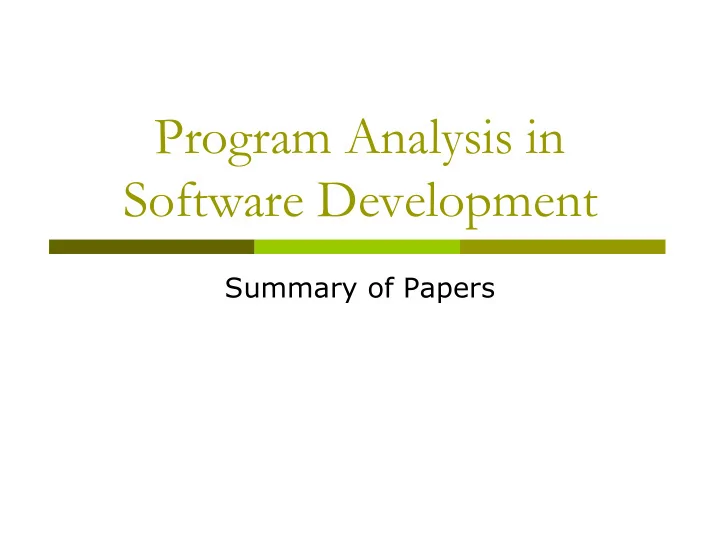

Program Analysis in Software Development Summary of Papers
Program Analysis Application Areas Compilation and Optimization LLVM: A Compilation Framework for Lifelong Program Analysis & Transformation Obfuscation Generation and Detection Abstract Stack Graph to Detect Obfuscated Calls in Binaries Model checking and code generation Model Checking and Code Generation for UML State Machines and Collaborations Reverse engineering Static Control-Flow Analysis for Reverse Engineering of UML Sequence Diagrams Program understanding Selecting, Refining, and Evaluating Predicates for Program Analysis Error detection and Testing Variably Interprocedural Program Analysis for Runtime Error Detection Program Maintenance Evaluation of Software Modernization Estimation Methods Using NIMSAD Meta Framework
Studying The Literature For each of the papers presented What does it try to accomplish? What are the main steps in the proposed approach? What can it be used for? What are its limitations? What is the role of program analysis in each of the application areas?
Example: Compilation and Optimization LLVM: A Compilation Framework for Lifelong Program Analysis & Transformation What does it try to accomplish? provide high-level information to compiler transformations at compile-time, link-time, run-time, and in idle time between runs What are the main steps in the proposed approach? a common low-level code representation in SSA form a simple, language-independent type-system instruction for typed address arithmetic simple mechanism for exception handling A compiler design that preserves program information and support Offline code generation, profiling, whole-program optimization,…
Example: Compilation and Optimization LLVM: A Compilation Framework for Lifelong Program Analysis & Transformation What can it be used for? Enable life-long optimization for whole-programs, e.g., compile-time, link-time, run-time, and in idle time between runs What are its limitations? (would you use it? What are your concerns?) Requires the adoption of a new IR (intermediate/internal representation) and a new virtual machine (LLVM) Conversion between other languages? Support offline code generation, but is that sufficient? Others … The role of program analysis in compilation and optimization Discover semantics of programs (persistent program information) Discover opportunities for optimization
Other application areas? Obfuscation Generation and Detection Abstract Stack Graph to Detect Obfuscated Calls in Binaries Model checking and code generation Model Checking and Code Generation for UML State Machines and Collaborations Reverse engineering Static Control-Flow Analysis for Reverse Engineering of UML Sequence Diagrams Program understanding Selecting, Refining, and Evaluating Predicates for Program Analysis Error detection and Testing Variably Interprocedural Program Analysis for Runtime Error Detection Program Maintenance Evaluation of Software Modernization Estimation Methods Using NIMSAD Meta Framework
Recommend
More recommend